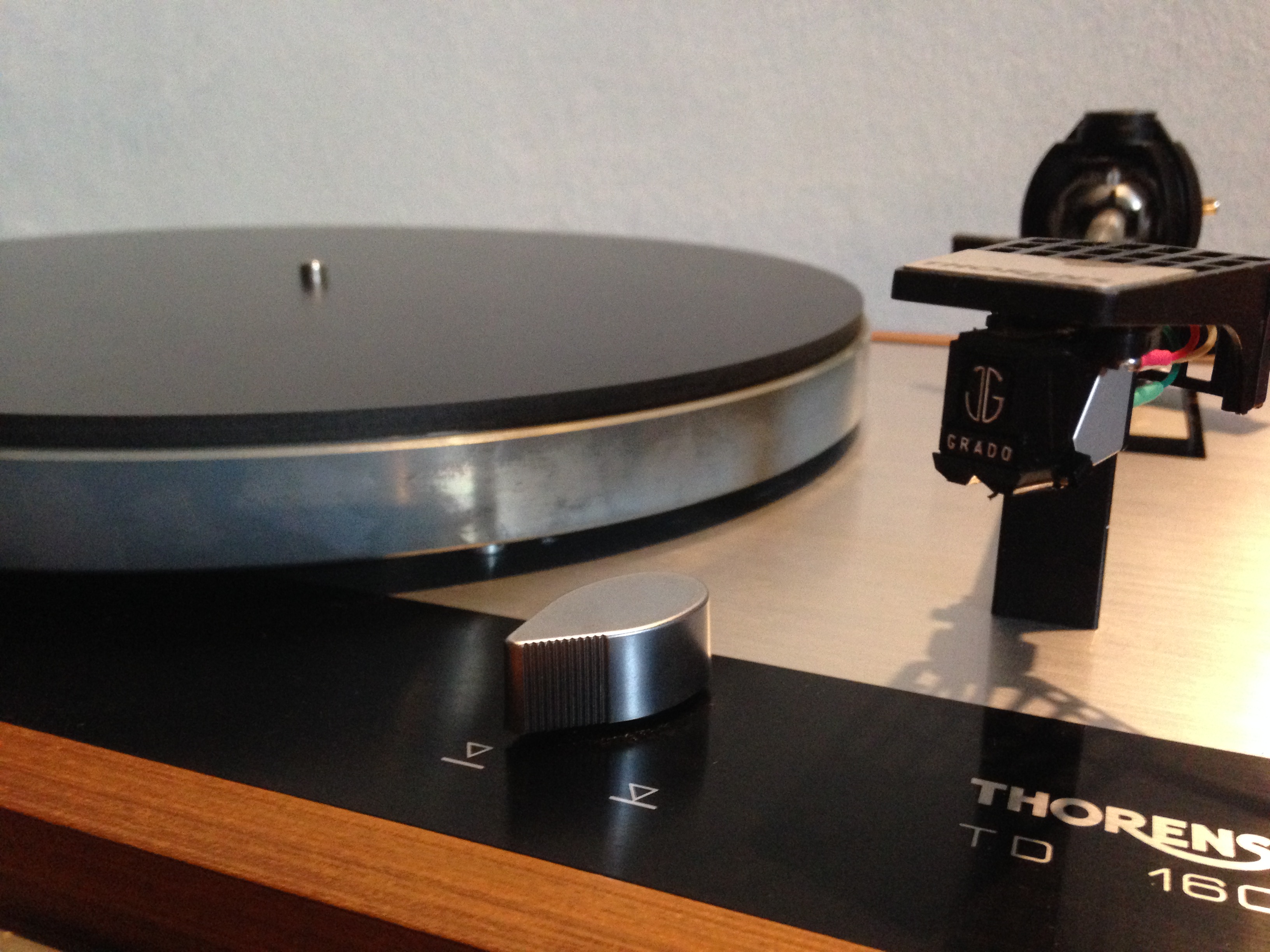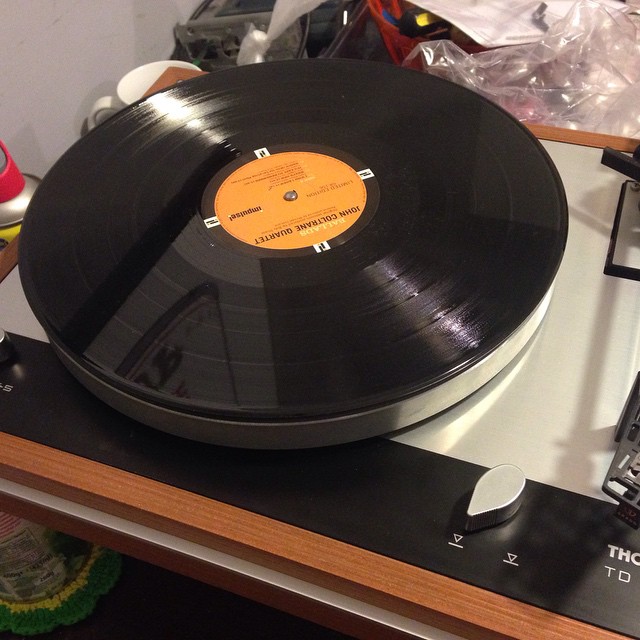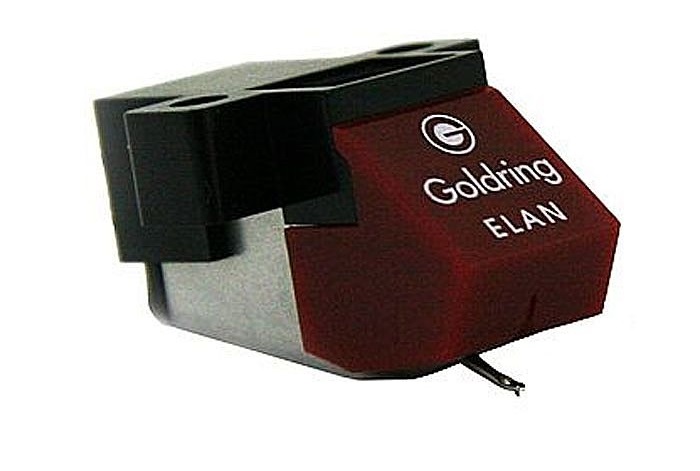Today my turntable is a beautiful Thorens TD-160 from the 70s, which I purchased in 2015 at a ridiculous price as an upgrade from my old TD-165. At first, I’ve only dampened the bottom board with tar sheets and installed larger feet. I replaced the original rubber mat with a Funk Firm Achromat and installed a Shure M97 Era IV cartridge. Then I’ve replaced the original RCA cables with low capacity Van Damme OFC cables, also rewiring the ground connection, only to have recently come back to the original feet and cables, replacing just the RCA plugs.
The Thorens TD160 does not fear many comparisons. When properly set up it can achieve excellent performance even if compared with many modern turntables. In other words, it is difficult for it to be beaten by a Rega Planar 3 (it is more a matter of different “presentation”) but even the Linn Sondek LP12 does not always win against the old Thorens. In short, to do significantly better than a TD160 you have to spend quite a bit of money. But it is a type of turntable that requires special attention.
How I went back to vinyl
By the mid 80s, my analogue source was just a cassette deck, first the old Technics M7, then an Aiwa, finally a Teac V1050, nothing special but good enough. My old turntable had some aging issues. I didn’t scrap all my record collection but I no longer played LPs. Eventually, even I ended up buying a basic CD player and started creating my digital collection. Like many, I was dumbfounded when I heard and read about how the music industry and CD manufacturers had tricked all of us by selling us the CD superiority story just to revive the market. But it happens everywhere.
The same friend of mine who bought my JVC CD player and the Onkyo amp, still had his late father’s old turntable. Ready to embrace any new technology, this friend of mine soon put away an old Thorens TD-165, a 1972 project I kept asking a price for. When one day I saw the poor Thorens thrown away in a locker I told the guy it would have been better if I used it. So, first time in my life, I had some free High Fidelity. Many years after, having learned a lot about those historical turntables, I thought about buying some more used for refurbishing, tuning and reselling them. In May 2015 I stumbled upon a very good bargain and I fell into temptation: I bought a TD-160 in very good conditions…
Thorens history
Thorens exists since right after Edison invented his phonograph machine. Herman Thorens founded the company in 1883 in St. Croix, Switzerland, manufacturing “musical boxes” and “sound motion” machines. In 1928, they had 1200 employees, diminished to 800 with the great depression, and they started designing electrical motors for gramophones. Record pressing machines started in 1940 and the first turntable was out by 1943. In 1957, the first mythical Thorens turntable was born: the TD-124. It featured a heavy rigid plinth and a massive metal platter. The built quality was superb – the state of art of the time. It was an instant success. Thorens already manufactured also much cheaper turntable than its top-of-line. Later, in 1959, the stereo sound was born and all Thorens model where upgraded to play stereo. In 1963, the production was moved to Lahr, Germany, in the middle of the Black Forest. In 1965, Thorens produced their first belt-driven, floating chassis turntable, the TD-150. Thorens started an intens collaboration with the nearby EMT that was building professional turntables. The result was the TD-124 evolution, the Thorens TD-125 in 1968. It featured an electronic in stead of magnetic motor control and still it was a belt-driven, floating chassis deck. This technology allowed for a very good acoustic and mechanical insulation, while less complex and bulky plinths could be used. This favored a mass success of Thorens turntables – headed by the revolutionary TD-150 – that were more easily accepted in average homes for their ease of placement among normal furniture. The TD-150 MKII was born in 1969; in 1973 the TD-160 was offered, with the TD-165 as its basic version, while the TD-125 MKII was out right after.
Comparing the TD-160 and the TD-165 – technical characteristics of old Thorens decks
Comparison between the two Thorens decks I have had: TD-165 vs. TD-160
Typical floating chassis turntables, the Thorens use a 3 spring suspension system to isolate the chassis from ambient vibrations and motor noise. Main compatitors of the time were Linn, ERA, Garrard and AR. The basic Thorens TD-165 was equipped with a TP-11 tonearm and TP-60 headshell. The more refined TD-160 featured a metal subchassis with a 10 mm bearing shaft (the TD-165 has a resin subplatter with a 7 mm bearing, thogu many, like mine, had a 10 mm one); the tonearm was the TP-16, more advanced according to many, more problematic because its higher complexity according to others. The TP-16 had a different counterweight and a magnetic antiskating mechanism, while the TD-165’s TP-11 used an elegant threaded weight system – for the rest the two turntables are identical.
On the outside, the TD-160 had a black band under the command side, making it easily recognizable. The knobs were metallic, while the TD-165’s were black plastic. The TD160’s plastic motorpulley had a clutch system allowing a more rapid start and stop; the TD-165’s pulley is still plastic but with no clutch, so the platter rotates until frictions sops it or you have to do it by hand. The higher weight of the TD-160’s metal subchassis (nearly 500 g) needed maybe (?) stronger suspension springs. In summary, the two turntables are very similar and are both very good looking. According to some, the TD-160 is far superior from the sonic point of view; other say the differences are minimal, perceivable but not fundamental, lke a better sens of rhythm and bass control. The best Thorens of the time are deemed the TD-124/125 and the TD-160 itself, having a simpler plinth and less electronics than the TD-125, although the same platter, tonearm an motor. Both TD-160 and TD-165 are directly derived from the TD-150. In 1976, the TD-165 was replaced by the TD-166 that added just the clutched motor pulley; the TD-160 was revisited as TD-160 MKII.
Cartridges I used
A Thorens from the 70s is maybe the first step in the world of true HiFi you can make with vinyl. If well tuned they all sound wonderfully. The Thorens TD-165 was the Swiss company’s entry level in the mid 70s; in Italy it used to cost around 95 thousand Lire. The TD-165 makes simplicity its strength: a few things but done well. The TD-160 is universally renown as a turntable still worth of modern top-level HiFi system.
When I took the TD-165 away from that friend of mine, as first thing I bought a new moving magnet (MM) cartridge. I asked advice to a HiFi shop that sold me a Golding Elan for 80 thousand Lire. He claimed that was all that “deck” deserved. Later I swapped the thin phono cables with simple low capacity, coaxial microphone cables; I also scrapped the original power chord.
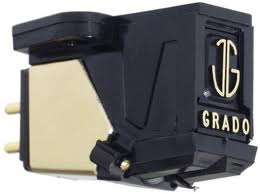
First real upgrade: a Grado Prestige Gold cartridge in 2005 (first series)
A few years later I found out on the Internet that that “deck” would be worth of much more. In 2005, after advice from TNT-Audio’s ever helpful Lucio Cadeddu, I purchased a Grado Prestige Gold cartridge, still operating today on the TD-160. In 2010 I had to renew the stylus with a Gold1 replacement and in 2015 I upgraded to the Grado 8MZ Signature stylus – an incredible quality advancement: some claim it is comparable to the sound of top Grado carts, for just 100 euros! Unfortunately, I dropped the stylus while attempting to move it on another cartridge and the damage appears to be limited to an evident drop of the signal level.
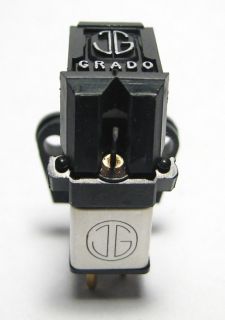
In 2016 I bought a used Grado Signature 8MX. I’ve never tested it with the famous 8MZ replacement stylus
In 2016, I purchased a used 1986 Grado Signature 8MX body, which I mounted on a spare TP60 headshell. As of now, I’m using it with the Gold1 stylus with excellent results on my new TD-160. I equipped the turntable with Van Damme Silver Plated OFC cables and gold plated Neutrik hooked to an excellent Lehman Black Cube phono stage, and of course using the Funk Firm Achromat. Each one of these upgrades, in time order Achromat, Black Cube, Van Damme cables, I obtained a notable improvement of the Thorens TD-160’s performances.
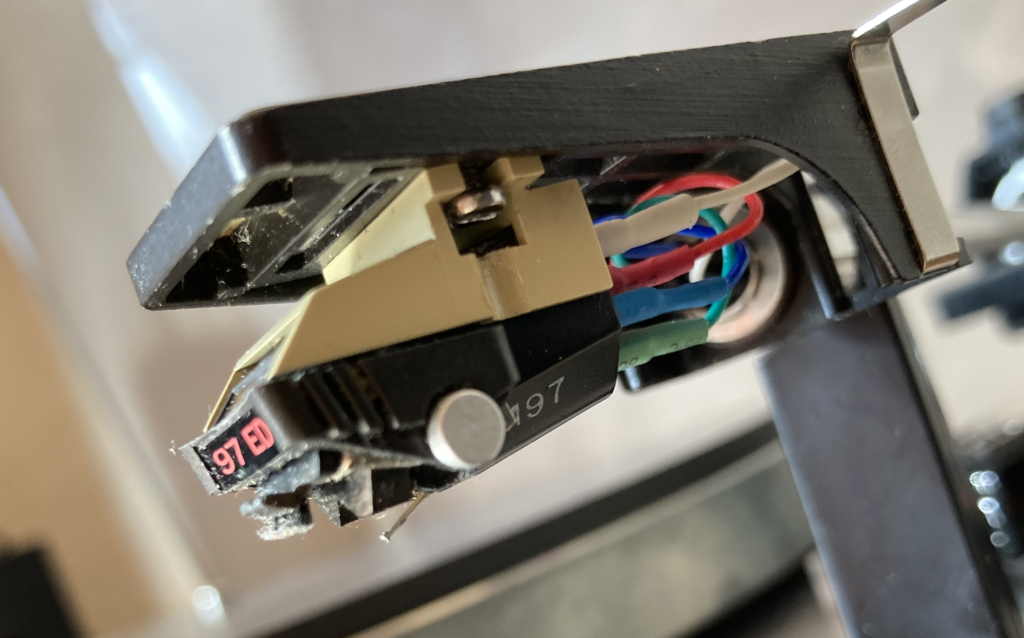
My current Thorens TD-160 is running with a Shure M97 Era IV body and a Nagaoka N97ED elliptical stylus
In 2018 I stumbled upon an old discarded turntable, not working but with a Shure cartridge with a broken needle. It is a Me97HE, the Mexican re-edition of the M97HE, a cartridge revered in its most recent edition, the “Era IV”, just below the V15 IV in the Shure 70s catalog. The HE ending stands for hyperelliptical (the diamond cut of the reading tip), in contrast to the elliptical one designated as ED in the Shure house. The “lightened” version, called Encore, is considered identical to the M97, but actually has the same electrical as the M97xE and therefore a similar design attenuation of high frequencies. Even with the cheap Nagaoka N97ED stylus I was still amazed when I heard it on my Thorens TD-160, in operation after several months in a drawer! This series of Shure cartridges (M97, V15IV, V15IV) is considered by many to be a reference for extremely flat response between 20 and 20k Hz. In the end I was convinced and found a very good M97HE Era IV.
Future advancements
The Grado 8MX can be further upgraded with an 8MZ stylus but it is now damaged and plays ar a lower level. A good upgrade could be an MCZ stylus (that needs to be loaded differently through a capable phono pre or with a series of resistors). To this day, the legendary Shure M97HE is the number one cartridge on my turntable, with its flat response and the copious, assertive, realistic sound that sets it apart. It is not out of the question that one day I may try something more modern like the Audiotechnica AT-VM95ML.
For many, the TD160 would deserve a tonearm commensurate with its class. Others, however, consider the standard TP16 on the Thorens TD-160/145 to be an excellent arm. A classic replacement tonearm is the SME 3009 in version II “Improved” but was used in those days when cartridges had high compliance, unlike today’s cartridges.
The Rega RB200 or 300 are also not bad but the problem seems to be that, having too high a base, a permanent modification to the Thorens platter is needed (“filing” some wood to mount the Rega arm at the right height). Alternatives might be found in Grace or Mayware tonearms. At the moment the prices of analog audio, including unfortunately the records themselves, are so exorbitantly high that I do not think it is worth investing further. And several testimonials in favor of TP16 even compared to many of the alternative tonearms discourage replacement work.
Resonance frequency of the tonearm-headshell system
The tonearm/cartridge pairing should be taken into account; this is done by calculating the resonance frequency of th cantilever, the thin segment the needle is attached to. The calculation includes the tonearm’s effective mass (Me), the cartridge’s weight (Mc) and its compliance (C), which is a measure of its resistance to the imposed weight; the weight of mounting screws, shims, etc. (Mf) is also to be input in the following formula:
![]() The formula yields the resonance frequency in hertz; it should stay within the 8 – 15 range (8 – 12 according to some), away from typical rotating platter resonance (around 4 hz) and from the bottom end of the audible range (20 hz). The ideal value is around 10 hz. My current system includes the TP-16 MKI with a 16.5 g effective mass; I saved nearly half gram by removing the Metal logo plate and another plastic piece from the shell. My Grado Gold weighs 5.5 g (although declared at 6 g) and has a 20×10^6 cm/dyne compliance. Taking into account about 0.7 g of screws and shims, I obtain a 7.5 hz resonance frequency, unfortunately out of the suggested range. Nevertheless, I do not experience any problems. Actually, I later purchased the HiFi News test record HFN 003: the resonance frequency check track gives a result of 13 Hz. Far better! Some believe the HiFi news record has the wrong frequencies; that would mean my result is actually 11 Hz – perfect! The more so since the infamous torture track n. 9, where the best cartridges are said to be spat out of the record, has been tracked with almost no hassle! I’m really satisfied. Even the 8MX cart has performed well on the test record. The resonance frequency has been tested at around 9-10 Hz, therefore it should be around 8 Hz, actually, near the lower limit. This is maybe because I’m using the cart on the unmodified headshell.
The formula yields the resonance frequency in hertz; it should stay within the 8 – 15 range (8 – 12 according to some), away from typical rotating platter resonance (around 4 hz) and from the bottom end of the audible range (20 hz). The ideal value is around 10 hz. My current system includes the TP-16 MKI with a 16.5 g effective mass; I saved nearly half gram by removing the Metal logo plate and another plastic piece from the shell. My Grado Gold weighs 5.5 g (although declared at 6 g) and has a 20×10^6 cm/dyne compliance. Taking into account about 0.7 g of screws and shims, I obtain a 7.5 hz resonance frequency, unfortunately out of the suggested range. Nevertheless, I do not experience any problems. Actually, I later purchased the HiFi News test record HFN 003: the resonance frequency check track gives a result of 13 Hz. Far better! Some believe the HiFi news record has the wrong frequencies; that would mean my result is actually 11 Hz – perfect! The more so since the infamous torture track n. 9, where the best cartridges are said to be spat out of the record, has been tracked with almost no hassle! I’m really satisfied. Even the 8MX cart has performed well on the test record. The resonance frequency has been tested at around 9-10 Hz, therefore it should be around 8 Hz, actually, near the lower limit. This is maybe because I’m using the cart on the unmodified headshell.
According to math, should I look for a lower compliance cartridge. It appears the formula is not really reliable, but there is people who believe the Grado stylii’s compliance is far lower than declared: calculating C with a 11 Hz resonance frequency, it would give 9.5 versus the 20 x10^6 cm/dyne declared compliance! I could mount a lighter arm like the 6.5 g SME 3009 Improved (or somehow lighten up mine), but it seems, against popular beliefs, that Grado carts get along very well on Thorens arms. Eventually, my good old Thorens could deserve a better tonearm one day but it will have to battle against the flattering performance of the TP-16 MKI…
Speaking of low compliance, normally a Shure cartridge would not be suitable for arms like those on 1970s Thorens (yet you can often find them paired together). Today I have a Shure M97 Era IV with a Nagaoka stylus. The Shure’s brush damping system was also designed to be able to pair it with heavier tonearms than the Thorens. With the damping brush down, the Shure blows away all of the excellent performances mentioned above, exhibiting exemplary behavior on any test track it is challenged with! A true masterpiece…
Thorens TD-160 user manual on theanalogdept.com
Thorens TD-165 user manual on theanalogdept.com
How to recognize various SME 3009 tenearms on analogue-classics.com
Audiomods modified Rega arm on tnt-audio.com
Origin Live modified Rega arm on tnt-audio.com
Grado Prestige Gold1 on tnt-audio.com
Grado Prestige Gold on needledoctor.com, on HiFi Choice and on stereophile.com
Interview to John Grado on head-fi.org
Goldring G 1042 MM on tnt-audio.com
Denon DL-103 on tnt-audio.com
